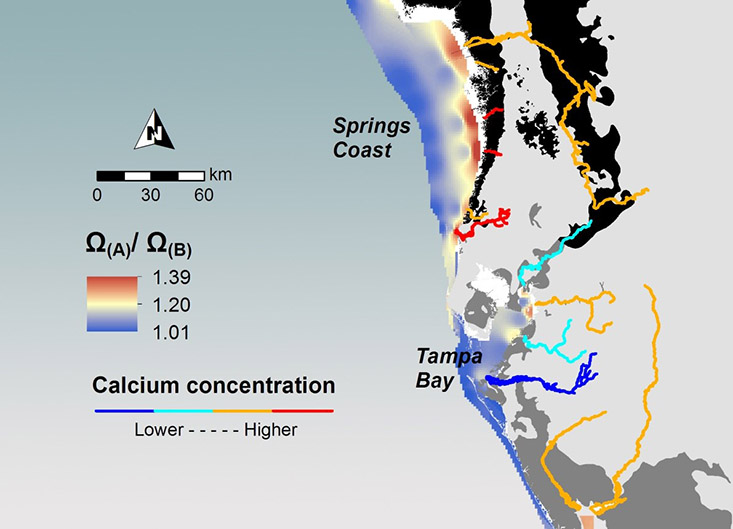Written by Sean Beckwith, PhD student
ST. PETERSBURG, FL – The oceans are warming, losing oxygen, and growing more acidic, and this study sheds light on how some coastal areas may have greater immunity to these changes than others. Which ecosystems might persist in spite of climate threats?
These global changes are likely impacting the open ocean in a more uniform way than the highly variable coastal waters, and certain coastal regions might provide greater refuge against stressors than waters offshore.
An area known as the Springs Coast (Florida, USA) offers a striking example of the diversity among coastal waters and whispers of the importance of studying regions that proffer refuge against the storm that climate experts predict in the absence of substantial reductions to human emissions of greenhouse gases.
Organisms that use calcium and carbonate ions to build shells and other portions of their morphology for protection or function are among the most vulnerable to ocean acidification in particular. As CO2 increases and pH drops, changes in seawater carbonate chemistry are forcing these organisms to invest more energy into the construction of their shells, hinges, appendages, and otherwise.
Several indicators are useful for defining the condition of seawater in terms of an organism’s ability to calcify. One of the most commonly used is the calcium carbonate saturation state, represented by the Greek letter Ω.
In this publication, we demonstrate a model that highlights the contribution of riverine calcium concentrations to Ω. The calcium ion is commonly treated as a ‘conservative’ ion in marine systems, meaning that it is calculated in proportion to salinity. While salinity is a required measurement for CO2 system chemistry, calcium is typically ignored, and, in brackish coastal waters, this can cause large errors in the calculation of Ω. The model can be used as a tool for identifying coastal regions that show greater calcification potential for shell-building organisms.
For example, on the Springs Coast, first-magnitude spring-fed rivers emerge from ancient limestone substrata delivering high concentrations of calcium and carbonate several kilometers out across the shallow coastal shelf. Submerged aquatic vegetation (most notably seagrass) plays an integral role in drawing down CO2 and maximizing the high concentrations of carbonate contributed by the coastal spring-fed rivers. The combination of spring-fed rivers and abundant seagrass means that this region is perhaps more immune to the effects of acidification than other regions.
The application of the model is limited to brackish waters yet is globally relevant. We envision it as a preliminary tool to elucidate regional differences in calcification potential which can be further explored by high-resolution methods. Subsequently, the hope is that conservation efforts will focus on including regions with exceptional calcification potential.
In conjunction with ecologically guided urban development, high-return conservation practices might allow nature time to recover from the fallout of rapid human expansion and encroachment.
Publication Title: Riverine Calcium End-Members Improve Coastal Saturation State Calculations and Reveal Regionally Variable Calcification Potential
Authors: Sean Beckwith, Robert H. Byrne, Pamela Hallock
Abstract: Carbonate-rich groundwater discharged from springs, seeps, and spring-fed rivers on carbonate platforms creates environments of potential refuge for calcifying organisms in coastal waters by supplying higher [Ca2+] and [CO32-] along with typically lower nutrient concentrations. The benefits associated with carbonate terrains are maximized in the presence of submerged aquatic vegetation, especially seagrasses. To improve the accuracy of carbonate saturation state (Ω) determinations, calculated values of [CO32-] and Ksp* were paired with [Ca2+] values determined using a model that incorporates directly measured riverine calcium end-members (model A). This model results in Ω values larger than those calculated by assuming that [Ca2+] is directly proportional to salinity (model B; e.g., using CO2SYS, CO2calc). As an example, for salinity (S) between 13.5 and 24, improvements in saturation states calculated as differences (ΔΩ) between model A and model B saturation states in the tidal mixing zone of the Weeki Wachee River (Florida, USA) ranged from 0.39–1.00 (aragonite) and 0.61–1.65 (calcite). Saturation state ratios (Ω(A)/ Ω(B)) for coastal waters with enhanced [Ca2+] originating from carbonate-rich groundwater can be calculated from end-member calcium concentrations and salinity. Applied to several river systems in the conterminous United States, Ω(A)/ Ω(B) values calculated at S = 20 lead to Ω(A)/ Ω(B) ratios of 1.12 (Weeki Wachee), 1.09 (Anclote), 1.06 (Mississippi), and 1.03 (Columbia). These increases in saturation states can be used to identify potential calcification refugia for subsequent high resolution field studies that focus on, for example, the long-term viability of oyster communities and other calcifying organisms in brackish coastal waters.
